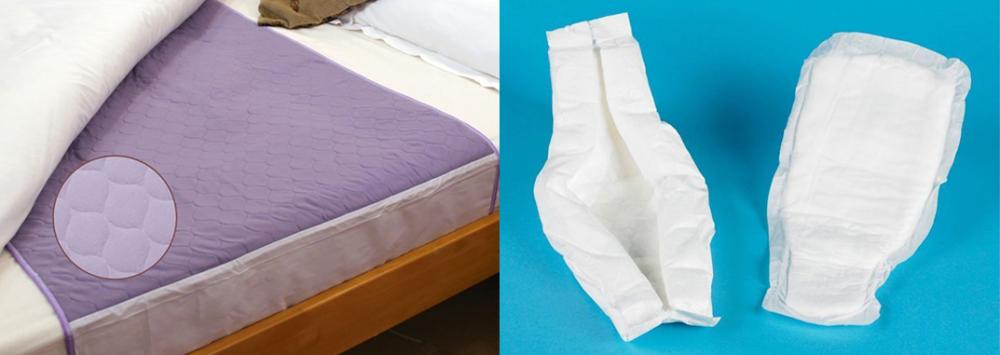
Managing Incontinence and Maintaining Hygiene
Sally Madeley-Carr, OT14 Jul 2021
Age may cause us to slow down and to take things easy, meaning that regular exercising of muscles doesn't happen as a matter of course. Muscle deterioration can make easy-to-do tasks become more of a challenge.
Elderly people may also develop bladder problems which, teamed with a change in dexterity and mobility, may make visiting the toilet a slower task.
About one in four elderly people experience bladder weakness and one in ten bowel incontinence.
Onset of Incontinence
Incontinence can appear slowly as a result of a variety of factors:-
- incontinence is quite often a result of the weakening of the pelvic muscles but is not a topic which is freely discussed, owing to shame and embarrassment. Regular exercises targeted towards the pelvic muscles can help lessen the condition
- a urinary tract infection can often be the cause of incontinence and this is easily treatable with medication some medications for other conditions can cause incontinence as a side effect, so changing that medication to a different one should correct the temporary inconvenience
- onset of incontinence can also be as a result of several medical conditions (irritable bowel syndrome, MS (multiple sclerosis), constipation and prolapse), so always make your local doctor the first point of call, to establish individual needs
- incontinence can also develop in the later stages of dementia and Alzheimer's disease.
Certain lifestyles can cause / exacerbate incontinence:-
- smoking - constant coughing can weaken the pelvic floor muscles
- lifting - moderate to heavy lifting (e.g. lifting shopping and carrying children) can also weaken the pelvic floor muscles
- being overweight - fatty tissue pressing against the bladder can give rise to incontinence
- constipation - 'straining to go' can also weaken the pelvic floor muscles and can worsen urinary incontinence
- too much caffeine - caffeine is present in tea, coffee, hot chocolate, fizzy drinks, green tea, energy drinks, caffeine irritating the bladder and so worsening urinary incontinence.
Whilst caffeine should be avoided, or at least reduced, an elderly person needs to drink between 1 1/2 and 2 litres (2 ? to 3 ? pints) of liquid per day, to stay both healthy and hydrated and should not drink less to hide / manage the inconvenience or embarrassment of incontinence.
Special Equipment Available to Manage Incontinence
- Daytime
Incontinence Pads and Pants
Incontinence pads are constructed using the same technology as that for babies' nappies, the hydrophobic layer drawing urine away from the surface of the pad, allowing the user's skin to stay dry.
Disposable incontinence pants (sometimes referred to as 'adult pull ups') come in a range of different sizes and are also available in male and female designs. Ideal for those with more active lifestyles, they offer different levels of absorbency and can be used for both urinary and bowel incontinence.
An inbuilt back sheet in disposable pants allows a through flow of air, allowing the skin to breathe.
When searching for the best incontinence pads or appropriate underwear, always check what the product provides, as the cheaper products may prove more costly in time taken on more frequent changes.
Products can be disposable or washable, so always check which will be most cost effective for the temporary or long-term needs of the individual, as well as which proves to be most suitable / comfortable.
Shop for incontinence pads which will last up to six hours, so that the wearer will be more comfortable for longer and less inconvenienced by constant changing.
Incontinence pants offer various levels of protection so, again, check what the product provides and establish that they will offer the wearer what he / she needs. Note that a high level of absorbency helps to neutralise odours.
Seat Protection
For people with limited mobility, getting 'caught short' may happen from time to time. Incontinence accidents during the day may also happen, so look towards protecting seats which the individual uses regularly.
Waterproof (whilst also washable) seat and chair pads will protect upholstery from incontinence damage, minimise odour and will keep that favourite chair going for much longer.
Seat and chair pads are discreet and don't look out of place in the home environment, posing simply as extra padding / cushioning for the user.
NB - When bladder incontinence is extreme, the use of a catheter (a flexible tube used to empty the bladder) may prove to be the only true option. Inserting and removing a catheter can only be done by professional healthcare workers and trained caregivers.
- Nighttime
Trying to Get a Good Night's Sleep
Whilst it is necessary to drink enough water to stay hydrated, try to refrain from drinking too much liquid in the two hours leading up to bedtime.
Remember that alcohol, and also drinks which contain caffeine, can irritate the bladder and lead to worsened urinary incontinence.
Our body recognises a need for sleep. Keeping to a regular routine as to the time to call an end to the day will indeed help with quality of sleep. Such a routine may also prove to lessen any need for sleeping tablets.
Mattress Protection
Mattress protection not only protects the mattress from damage from incontinence accidents but also keeps the mattress dry when an elderly person needs bed baths e.g. due to lack of strength or mobility, or during periods of weakness through illness.
Washable Bed Pads
Whilst a mattress protector is a good method of hygiene for all people, a washable bed pad provides extra padding for people for whom incontinence has become a concern.
Washable bed pads add a comfortable layer of highly absorbent thickness which holds accidents within the washable bed pad itself, preventing all of the dampness from reaching the user, the mattress or overall mattress protector.
A washable bed pad holds the liquid within its fibres and allows the user to sleep more comfortably and for longer. Washable bed pads fit all bed sizes i.e. single, double and king and can be used on top of, as well as under, the whole bed mattress protector.
Look for washable bed pads which have waterproof backing, keeping the bed dry underneath the pad.
Before purchasing, decide what level of absorbency is best for the user.
Whilst it might be commonplace in all households to change bed linen once a week, the use of washable bed pads for those with incontinence concerns will help limit the number of times that the whole bed linen will need to be changed.
Washable bed pads can be cleaned in the washing machine and some types can be tumble dried. Remember to read the product details before purchasing.
Bed Baths
Feeling clean and fresh contributes highly to the quality of our day.
When supporting a person who is confined to bed with having a bed bath, line the bed with several layers of towels, or a washable bed pad, to prevent the bed becoming damp. This will cut down on the need to have to change all of the linen on the bed.
Cover the individual with a towel, both for modesty and for warmth. Reveal only the part of the body which is being tended to, for the same reasons.
Help the individual roll over, so that all parts of the body can be accessed.
Dry the person thoroughly and apply moisturiser and / or powder, for both protecting the skin and for added comfort.
Washing the bed pad will be a quicker and more convenient process than having to change all of the bed linen (and maybe also washing the whole bed mattress protector) on the bed.
Limit bed baths to two or three times a week, as the individual's skin may develop irritable skin or bed sores, if the skin is damp too often.
Summary
If you believe a loved one is experiencing incontinence, approach this topic gently with the individual, not only to cope with incontinence but also to ascertain if the condition can be cleared via medication. Putting the individual's mind at rest will make the new routine easier to manage and complete.
If getting enough sleep is proving difficult, look at lifestyle changes (e.g. not drinking within two hours of going to bed, having a regular bedtime etc.), before opting for sleeping tablets, which can become addictive.
If bowel incontinence needs to be addressed, adding more fibre to one's diet (e.g. more fruit and vegetables, wholemeal bread and oatmeal) will help to improve this inconvenience. Eating more fibre will also minimise constipation which, in itself, can weaken muscles and adversely affect incontinence.
Using washable bed pads and seat pads, and changing them regularly, will stem any build up of unpleasant odour within the home.
Avoiding caffeine can go a long way towards handling incontinence.
Presence of bedsores must be managed, as worsening of this condition (maybe starting as reddening of the skin and leading on to deep damage which may expose bone) can prove fatal.
Remember that cheapest isn't necessarily the best route to take, as product performance is much more important.

Sally Madeley-Carr, OT
Sally qualified as an Occupational Therapist in 1996 and is a well-respected professional in the field of rehabilitation equipment and living aids. She has worked in private practice and within the NHS, developing a broad experience with adults and children. Click here for Sally's registration with the Health and Care Professions Council. The HCPC regulates health, psychological and social work professionals in the UK.